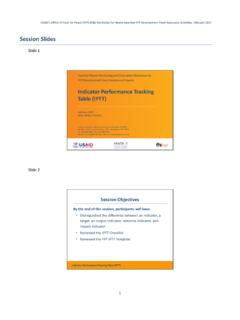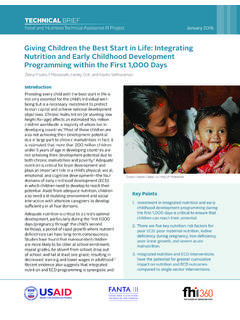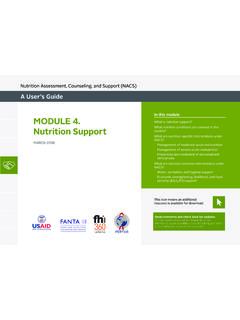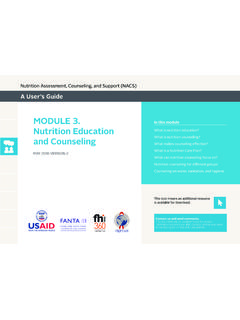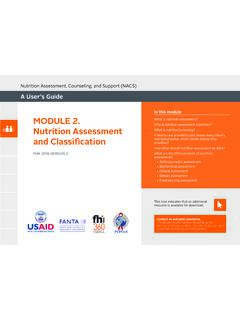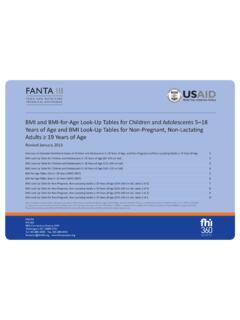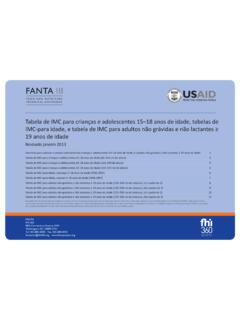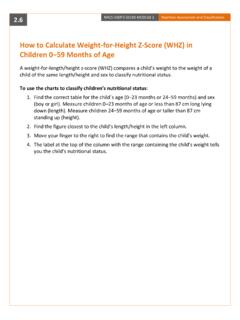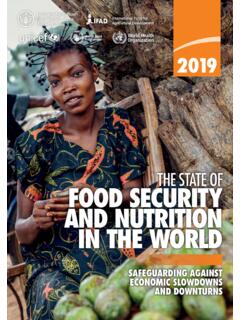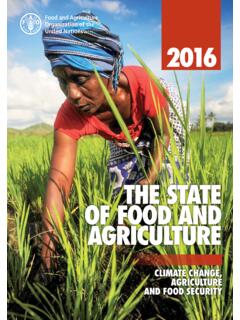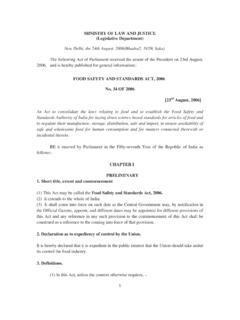Transcription of Household Food Insecurity Access Scale (HFIAS) for ...
1 Household food Insecurity Access Scale (HFIAS) for Measurement of food Access : Indicator GuideVERSION 3 August 2007 Jennifer Coates Anne Swindale Paula BilinskyFA NTAFHI 3601825 Connecticut Ave., NW Washington, DC 20009-5721 Tel: 202-884-8000 Fax: 202-884-8432 Household food Insecurity Access Scale (HFIAS) for Measurement of food Access : Indicator Guide VERSION 3 Jennifer Coates Anne Swindale Paula Bilinsky August 2007 food and Nutrition Technical Assistance III Project (FANTA) FHI 360 1825 Connecticut Avenue, NW Washington, DC 20009-5721 T 202-884-8000 F 202-884-8432 This publication was made possible by the generous support of the American people through the support of the Agency for International Development (USAID) Bureau for Global Health, Office of Health, Infectious Diseases, and Nutrition, under terms of Cooperative Agreement No.
2 HRN-A-00-98-00046-00, through the food and Nutrition Technical Assistance Project (FANTA), managed by FHI 360. The contents are the responsibility of FHI 360 and do not necessarily reflect the views of USAID or the United States Government. August 2007 Recommended citation: Coates, Jennifer, Anne Swindale and Paula Bilinsky. 2007. Household food Insecurity Access Scale (HFIAS) for Measurement of Household food Access : Indicator Guide (v. 3). Washington, : FHI 360/FANTA. Copies of the publication can be obtained from: food and Nutrition Technical Assistance Project (FANTA) FHI 360 1825 Connecticut Avenue, NW Washington, 20009-5721 T: 202-884-8000 F: 202-884-8432 i Table of Contents Acknowledgments .. i 1. Background .. 1 2. Adapting the Questionnaire .. 5 Overview of Questionnaire .. 5 Step 1: Review with Key Informants.
3 6 Step 2: Refining the Questionnaire .. 7 3. Interviewer Instructions .. 9 Organization of the HFIAS 9 Asking Questions and Recording Answers .. 10 Instructions for Individual Questions .. 4. Questionnaire Format .. 5. Indicator Tabulation Plan .. Household food Insecurity Access -related Conditions .. Household food Insecurity Access -related Domains .. Household food Insecurity Access Scale Score .. Household food Insecurity Access Prevalence .. References .. Appendix 1: Key Informant Interview Guide .. Endnotes .. 11 13 16 16 17 17 18 21 23 28 Household food Insecurity Access Scale Indicator Guide, i Acknowledgments This guide could not have been completed without the intellectual and technical contributions of Edward Frongillo, Cornell University and Beatrice Lorge Rogers, Tufts University.
4 The guide reflects very useful and practical feedback on earlier drafts from staff from the following institutions: Africare, American Red Cross, Catholic Relief Services, food and Agriculture Organization of the United Nations (European Commission Programme on food security ), food for the Hungry International, Freedom from Hunger, Land O Lakes International Development, National Center for Health Statistics, Save the Children-US, World Vision United States, Agency for International Development (USAID), and Department of Agriculture's Economic Research Service. We have also greatly benefited from the vision and support of Eunyong Chung at USAID throughout the process of developing the Household food Insecurity Access Scale . In Version 3 of the guide, the HFIAS questions have been refined to address the recommendations of the Nutrition and Consumer Protection Division, food and Agriculture Organization of the United Nations (FAO), which carried out HFIAS adaptation work in multiple countries under the EC/FAO food security Information for Action Programme.
5 We thank the Nutrition and Consumer Protection Division of FAO for its partnership with FANTA in work related to the HFIAS. Household food Insecurity Access Scale Indicator Guide, 1 1. Background food security is defined as a state in which all people at all times have both physical and economic Access to sufficient food to meet their dietary needs for a productive and healthy life (USAID, 1992).i Because it is a complex, multidimensional concept, measuring food Insecurity has been an ongoing challenge to researchers and practitioners alike. Until very recently, most Household -level measures of food Access , such as income and caloric adequacy, have been technically difficult, data-intensive, and costly to collect. USAID Title II and Child Survival and Health Grant programs require relatively simple, but methodologically rigorous, indicators of the Access component of Household food Insecurity (hereafter referred to as Household food Insecurity ( Access )) that can be used to guide, monitor and evaluate program interventions.
6 Over the past several years, USAID s food and Nutrition Technical Assistance (FANTA) project has supported a series of research initiatives to explore and test different options for meeting this need. This document is a guide for implementing one such option, the Household food Insecurity Access Scale (HFIAS), which is an adaptation of the approach used to estimate the prevalence of food Insecurity in the United States ( ) annually. The method is based on the idea that the experience of food Insecurity ( Access ) causes predictable reactions and responses that can be captured and quantified through a survey and summarized in a Scale . Qualitative research with low-income households in the provided insight into the following ways that households experience food Insecurity ( Access ) (Radimer et al., 1990, Radimer et al.)
7 , 1992, Wehler et al., 1992, Hamilton, 1997): Feelings of uncertainty or anxiety over food (situation, resources, or supply); Perceptions that food is of insufficient quantity (for adults and children); Perceptions that food is of insufficient quality (includes aspects of dietary diversity, nutritional adequacy, preference); Reported reductions of food intake (for adults and children); Reported consequences of reduced food intake (for adults and children); and Feelings of shame for resorting to socially unacceptable means to obtain food The eighteen-question Household food security Survey Module (US HFSSM) asks respondents to describe behaviors and attitudes that relate to these various aspects, also called domains , of the food Insecurity experience (Hamilton et al., 1997). For example, a question relating to perceptions of insufficient quantity asks whether any adults had to eat less than they thought they should.
8 The uncertainty-related questions include one about whether the respondent worried that the Household s food would run out. Responses to the US HFSSM are summarized in a Scale to provide a continuous indicator of the degree of a Household s food Insecurity . Cut-off points on the Scale enable categorical classification of whether households are food secure or not. These data are used to monitor food assistance programs and to report on national prevalence of Household food Insecurity . Recent field validation studies of this approach to measuring food Insecurity ( Access ) more directly, by constructing measures based on households experience of the problem, have demonstrated the feasibility and usefulness of the approach in very different, developing country contexts (Webb et al., 2002, Coates et al., 2003, Frongillo and Nanama, 2003).
9 The measures constructed were strongly correlated with common indicators of poverty and food consumption as well as with indicators currently used by Private Household food Insecurity Access Scale Indicator Guide, 2 Voluntary Organizations (PVOs) to monitor their food security -related activities. They were also sensitive to changes in the households situation over time, making them valid and useful for assessing program impact. There are other studies where US HFSSM questions have been translated, with some adaptation, to developing country settings and found to be correlated with poverty and food consumption indicators (Melgar-Quinonez, 2004, Perez-Escamilla et al., 2004). Furthermore, based on a review of evidence from 22 different Scale applications, a paper examining commonalities in the experience and expression of food Insecurity ( Access ) across cultures identified four domains and several sub-domains of food Insecurity ( Access ) that appear to be universal across different countries and cultures.
10 The paper recommended that questions related to these domains be used as the basis of future food Insecurity ( Access ) Scale measures (Coates, 2005). Based on this growing body of evidence, FANTA and its partners have identified a set of questions (see Table 1, Household food Insecurity Access Scale Generic Questions) that have been used in several countries and appear to distinguish the food secure from the insecure households across different cultural These questions represent apparently universal domainsiv of the Household food Insecurity ( Access ) experience and can be used to assign households and populations along a continuum of severity, from food secure to severely food insecure. The information generated by the HFIAS can be used to assess the prevalence of Household food Insecurity ( Access ) ( , for geographic targeting) and to detect changes in the Household food Insecurity ( Access ) situation of a population over time ( , for monitoring and evaluation).
